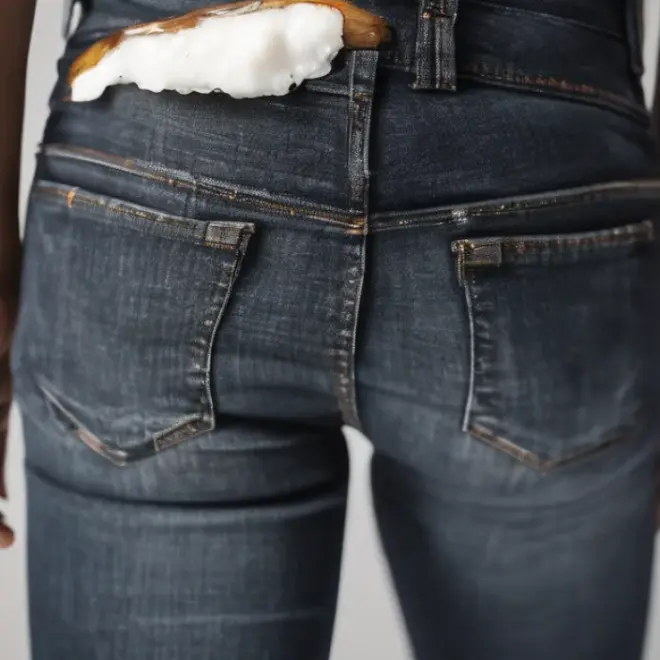You can easily hem baggy jeans using vinegar by washing them in hot water with distilled white vinegar. This shrinks the fabric, making them fit better. It’s a simple, no-sew method for a perfect fit.
How to Hem Baggy Jeans with Vinegar: Effortless Fix!
Are your favorite jeans a little too loose around the legs or waist? Don’t worry! Many of us end up with jeans that aren’t quite the right fit after some wear and tear. It’s a common style frustration, but thankfully, there’s a surprisingly simple and effective solution. You can adjust the size of your baggy jeans without a needle and thread. This easy method uses common household items and a bit of patience.
Get ready to transform those ill-fitting jeans into a pair that hugs your figure just right. We’ll walk you through each step, making it easy to achieve a great fit. Let’s get started on making your jeans look and feel brand new.
Why Your Jeans Might Be Baggy

Over time, denim can stretch out, especially if it contains elastane or spandex for comfort. High-waisted styles, in particular, can sometimes lose their shape around the top. This can happen due to frequent wear, improper washing (like using cold water or air drying), or simply the natural wear and tear of the fabric. The goal is to gently shrink the fabric back to its intended size. Understanding how denim behaves can help you care for it better in the future.
The Magic of Vinegar for Fabric Shrinkage

Distilled white vinegar is a fantastic, natural fabric softener and can also encourage shrinkage. When combined with hot water, the acidic nature of vinegar helps to relax and tighten the cotton fibers in denim. This process gently reduces the overall size of your jeans. It’s a gentler approach than many other shrinking methods, helping to preserve the integrity of the fabric while achieving the desired fit. Remember, this method is best for natural fibers like cotton, common in most denim.
What You’ll Need

Gathering your supplies before you begin will make the process smooth and efficient. You won’t need much, and most items are probably already in your home.
- Baggy Jeans: The pair you’re looking to hem.
- Distilled White Vinegar: The key ingredient for shrinkage.
- Hot Water: Essential for activating the shrinking process.
- Washing Machine: For the initial soak and wash.
- Dryer: To set the shrunken size.
- Measuring Tape (Optional): To check your progress.
Step-by-Step Guide to Hemming Baggy Jeans with Vinegar

Follow these simple steps to effectively shrink and hem your baggy jeans. The key is to use hot water and vinegar correctly.
Step 1: Prepare Your Jeans
First, ensure your jeans are clean. If they are dirty, wash them as you normally would using your regular detergent. This way, you’re starting with a fresh pair. Check any care labels on your jeans for specific washing instructions, though most denim can handle this process. If your jeans are brand new and you plan to shrink them significantly, you might consider doing this before wearing them extensively.
Step 2: Set Up the Vinegar Soak
In your washing machine, add your jeans. Then, pour in about 1 to 2 cups of distilled white vinegar directly into the drum with the jeans. You don’t need to add any laundry detergent for this step. The vinegar will act as your cleaning and shrinking agent.
Step 3: Wash with Hot Water
Select the hottest water setting your washing machine offers, ideally a “heavy duty” or “hot wash” cycle. This is crucial because hot water is what primarily causes the denim fibers to contract. The vinegar works in conjunction with the heat to enhance this effect. Let the washing machine complete its full cycle.
Step 4: The Dryer’s Role
Once the wash cycle is complete, do not remove the jeans immediately. Transfer the wet jeans directly into your clothes dryer. Set your dryer to its highest heat setting. The heat from the dryer will help to set the shrunken fibers and permanently reduce the size of your jeans. Dry them completely. You might want to run the dryer for an extra 15-20 minutes beyond what you’d normally use for a load this size to ensure maximum shrinkage.
Step 5: Check the Fit
After the drying cycle is finished, carefully remove your jeans from the dryer. Be cautious as they will be hot. Once they have cooled down enough to touch, try them on. Assess the fit around the waist, hips, and legs. If they’re still a bit too loose, you can repeat the process. Some fabrics and weaves might require a second round to achieve the desired reduction.
Step 6: Repeat if Necessary
If your jeans are still not as snug as you’d like, simply repeat Steps 2 through 5. You can repeat this process a couple of times. However, be mindful that repeatedly washing and drying jeans on high heat can eventually affect the fabric’s color and longevity. Aim to get them to the best fit within two or three cycles for optimal results and fabric care.
Advanced Tips for Vinegar Hemming

For those who want even more control or are dealing with specific fit issues, here are some advanced techniques.
Targeted Shrinkage
If only a specific part of your jeans is baggy (e.g., the waist but not the length), you can try a more targeted approach. You could pre-soak just the waistband in a mixture of hot water and vinegar before washing the entire garment. Alternatively, after the initial hot wash and dry, you could try a second wash cycle focusing on that area, perhaps by submerging just the waistband again in hot water and vinegar and then drying it.
Pre-Measuring for Precision
Before you start the whole shrinking process, measure your jeans and compare them to your desired measurements. You can also measure a pair of jeans that currently fit you perfectly. This will give you a clear target. While vinegar shrinking isn’t an exact science, having measurements can help you gauge how much you need to shrink and whether you might need to repeat the process.
Choosing the Right Vinegar
Always opt for distilled white vinegar. Apple cider vinegar or other types might contain sugars or other ingredients that could potentially stain or leave residue on your denim. Distilled white vinegar is pure, highly acidic, and breaks down effectively in the wash, leaving no lingering scent.
Understanding Denim and Shrinkage
Denim is typically made from cotton. Cotton is a natural fiber that can shrink when exposed to heat and moisture. The process involves the fibers absorbing water, swelling, and then contracting as they dry. The addition of vinegar acts as a mild acidic agent that helps to swell these fibers further, intensifying the shrinkage when heat is applied. The tighter the weave of the denim, and the higher the cotton content, the more it will shrink.
Here’s a look at how different denim compositions might react:
| Denim Composition | Likelihood of Shrinkage | Notes |
|---|---|---|
| 100% Cotton (Raw Denim) | Very High | Expect significant shrinkage. Often requires pre-shrinking. |
| 100% Cotton (Pre-Shrunk/Sanforized) | Moderate | Less shrinkage, but still may adjust with heat. |
| Cotton with Elastane/Spandex (e.g., 98% Cotton, 2% Spandex) | Low to Moderate | The elastic fibers limit dramatic shrinkage. May shrink slightly in length but less in width. |
| Blends (e.g., Polyester/Cotton) | Low | Synthetic fibers resist shrinkage. Minimal change expected. |
Knowing your denim’s composition can help set expectations. For jeans with a high percentage of synthetic fibers like polyester or spandex, this vinegar method will have a much milder effect. If your jeans are already very stretchy, they may not shrink much at all.
Pros and Cons of the Vinegar Hemming Method
Like any DIY fix, this method has its advantages and disadvantages. Weighing them can help you decide if it’s the right choice for you.
Pros:
- Cost-Effective: Uses inexpensive household items.
- No Sewing Required: Perfect for those who can’t or don’t want to sew.
- Natural Method: Avoids harsh chemicals.
- Simple: Easy-to-follow steps requiring minimal effort.
- Effective for Cotton: Works well on 100% cotton or high-cotton blend denim.
- Can Improve Fit: Helps to tighten loose waistbands and legs.
Cons:
- Unpredictable Results: Shrinkage amounts can vary greatly.
- Potential for Over-Shrinking: Jeans might become too small if repeated too many times.
- Fabric Wear: Repeated high heat can degrade denim fibers over time.
- Color Fading: High heat can contribute to color loss, especially with darker washes.
- Less Effective on Blends: Synthetic fibers resist shrinking.
- May Not Eliminate Wrinkles: Doesn’t necessarily create a sharp, crisp hem line like sewing.
When to Consider Other Methods
While the vinegar method is great for minor adjustments and for those who avoid sewing, it’s not always the best solution for every situation. If your jeans need a significant amount of shortening, are made from synthetic blends, or you desire a very precise, clean hem, other techniques might be more suitable. For instance, if you need to take in more than a couple of inches all around, or if the fit issue is specific to the rise of the jeans (e.g., too baggy in the crotch), you might need professional tailoring. For a crisp hem line without any stitching visible from the outside, sewing is the most reliable option.
Understanding Fabric Care and Longevity
Proper care for your denim will help them last longer and maintain their shape. While this vinegar method can be a quick fix, it’s not a substitute for good long-term care. Frequent washing, especially in hot water and high heat drying, can accelerate wear and tear on any fabric. For your favorite jeans, consider washing them less often, using cold water, and air drying them to preserve the fibers and color. For more information on extending the life of your garments, resources like those from the U.S. Environmental Protection Agency offer valuable tips on sustainable textile care.
Frequently Asked Questions (FAQ)
Q1: How much will my jeans shrink with this method?
A: Shrinkage can vary significantly. Expect anywhere from a small amount to potentially 1-2 inches in length and width for 100% cotton jeans after one cycle. Jeans with stretch fibers will shrink much less.
Q2: Will my jeans smell like vinegar after washing?
A: The vinegar scent is usually rinsed out during the wash and drying cycles. You shouldn’t notice any lingering smell on your dry jeans. If you’re concerned, you can add half a cup of baking soda to the rinse cycle.
Q3: Can I use this method on colored jeans?
A: Yes, you can use this on colored jeans, but be aware that high heat washing and drying can lead to some color fading over time, similar to regular hot washes. If your jeans are a dark indigo, this might be more noticeable.
Q4: What if my jeans become too small after trying this?
A: Unfortunately, once denim shrinks significantly, it’s very difficult to reverse. This is why it’s recommended to check the fit after each cycle and repeat only if necessary. If they become too small, consider them a learning experience and try again with a different pair, or perhaps a shorter hot cycle next time.
Q5: Can I hem my jeans by just washing them without vinegar?
A: You can achieve some shrinkage by washing in hot water and drying on high heat without vinegar, but the vinegar helps to intensify the effect and makes the fibers more receptive to shrinking. The vinegar adds an extra boost to the shrinking process.
Q6: How often can I repeat this process?
A: For best results and to prolong the life of your jeans, it’s advisable to repeat this method no more than two or three times. Excessive high heat and washing can weaken denim fibers and cause fading.
Q7: Is this method safe for all types of pants?
A: This method is primarily effective and safest for 100% cotton or high-cotton blend pants, especially denim. For delicate fabrics, silks, wools, or pants with a very high percentage of synthetic materials like spandex or polyester, this method is not recommended as it can damage fibers or yield poor results.
Conclusion
Transforming baggy jeans into a perfectly fitting pair doesn’t require a sewing machine or a trip to the tailor. By using a simple, natural method involving distilled white vinegar, hot water, and your dryer, you can effectively shrink your denim and achieve a fit you’ll love. Remember to start with clean jeans, use the hottest water setting available, and dry them on high heat. Check the fit after each cycle and repeat if necessary, but do so cautiously to avoid over-shrinking. This technique is a fantastic, budget-friendly solution for anyone looking to give their favorite jeans a new lease on life. Now you can confidently wear those jeans that have been sitting at the back of your closet!











